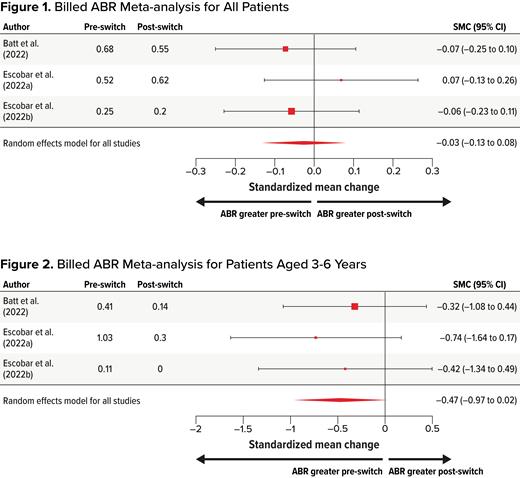Introduction
Individuals with hemophilia A (HA) are highly susceptible to bleeding due to a partial or total deficiency in factor VIII (FVIII). Replacement therapy with FVIII or nonfactor therapies (e.g., emicizumab) are used as standard prophylactic treatment for HA to prevent or reduce the frequency of bleeding episodes. Patients may switch from FVIII to emicizumab; however, the comparative clinical effectiveness of switching from FVIII to emicizumab is not well documented. We conducted a meta-analysis to assess the real-world evidence for annualized bleed rates (ABR) in the United States among noninhibitor patients with HA switching from prophylaxis with FVIII to emicizumab.
METHODS
We systematically reviewed publications related to real-world studies reporting bleeding outcomes in noninhibitor patients with HA who switched from 100% prophylaxis with FVIII therapies to emicizumab. PubMed, Embase, Cochrane Library, and EconLit databases were searched without date limitations. Publications were restricted to studies conducted in the United States. The studies that met the SLR inclusion criteria were included in the meta-analysis based on the analytical comparability of the studies (e.g., considering study design, patient population, endpoints). Meta-analysis was performed for billed (i.e., reported from retrospective claims data) ABR (ABR b), with sensitivity analysis for ABR b alongside observational (i.e., chart reviews) ABR data; subgroup analyses were conducted for 4 age groups (3-6, 7-12, 13-18, and ≥ 18 years). All effect sizes for all endpoints were calculated using standardized mean change (SMC). Data consistency was examined using the I 2 value and P value of the chi-squared test.
RESULTS
Of the 89 studies screened, 5 unique studies met the inclusion criteria and reported ABR data. Three studies were included in the primary meta-analysis based on their comparability with respect to population (noninhibitor patients only) and endpoint ABR b: Batt et al., 2022 (N = 121); Escobar et al., 2022a (N = 101); Escobar et al., 2022b (N = 131). In the primary analysis for ABR b, there was no statistically significant evidence to suggest a difference based on the SMC between pre- and post-switch ABR b (−0.03; 95% confidence interval [CI], −0.13 to 0.08) (Figure 1). There was no evidence to suggest heterogeneity in the effect sizes across the studies (I 2 = 0.00%; Q = 1.29; P = 0.52). The first and second sensitivity analyses included observational ABR from 1 and 2 additional studies, respectively. Including observational data increased heterogeneity, but both sensitivity analyses observed a nonsignificant negative pooled estimate of relatively small magnitude that denoted a numerical reduction between pre- and post-switch ABR b ([−0.12; 95% CI, −0.33 to 0.08] and [−0.15; 95% CI, −0.31 to 0.02], respectively).
Three studies were included in the age subgroup meta-analyses. For the age subgroup 3-6 years, a large negative pooled estimate with CIs that overlapped 0 was observed (−0.47; 95% CI, −0.97 to 0.02), relating to a nonsignificant decrease in ABR b between the pre- and post-switch periods (Figure 2). For the subgroup 7-12 years, a small, numerically negative pooled estimate with CIs that overlapped 0 was observed (−0.12; 95% CI, −0.37 to 0.12). For the subgroup 13-18 years, the pooled estimate was slightly positive but close to 0 with CIs that overlapped 0 (0.03; 95% CI, −0.24 to 0.31), relating to no statistically significant change in ABR b. For the subgroup of patients aged ≥ 18 years, a small, numerically negative, pooled estimate with CIs that overlapped 0 was observed (−0.01; 95% CI, −0.15 to 0.13). There was no statistically significant evidence to suggest a difference between pre- and post-switch ABR b based on the SMC for ABR b for any age subgroup. There was also no evidence to suggest heterogeneity in the effect sizes across the included studies for any age subgroup.
CONCLUSION
Meta-analyses indicated there was limited evidence for a statistically significant reduction in ABR after switching to emicizumab. Age may have been an important factor influencing the change in ABR b observed after switching to emicizumab. Overall, there was no statistically significant change in ABR b in any age group. The largest nonsignificant improvement in ABR b was found in patients in the youngest age group (3-6 years). Furthermore, the magnitude of any effect of emicizumab reduced with increasing patient age groups.
Disclosures
Escobar:Sanofi: Consultancy, Research Funding; uniQure: Consultancy, Research Funding; Bayer: Consultancy, Research Funding; LFB: Consultancy, Research Funding; HEMA Biologics: Consultancy, Research Funding; Takeda: Consultancy, Research Funding; Pfizer: Consultancy; Kedrion: Consultancy; NHF: Consultancy; CSL Behring: Consultancy; Genentech: Consultancy, Research Funding; Novo Nordisk: Consultancy, Research Funding; BioMarin: Consultancy. Fan:Takeda: Current Employment, Current equity holder in publicly-traded company. Mokdad:Takeda: Current Employment, Current equity holder in publicly-traded company. Tarantino:Biomarin: Consultancy; Genentech: Consultancy; Novartis: Consultancy; Octapharma: Consultancy, Other: Clinical trial investigator; Principia: Consultancy; Takeda: Other: Clinical trial investigator, Research Funding; Spark: Other: Clinical trial investigator; Amgen: Consultancy. Hawe:Takeda: Research Funding. Fernandez:Takeda: Research Funding. Bullano:Takeda: Current Employment, Current equity holder in publicly-traded company.


This feature is available to Subscribers Only
Sign In or Create an Account Close Modal